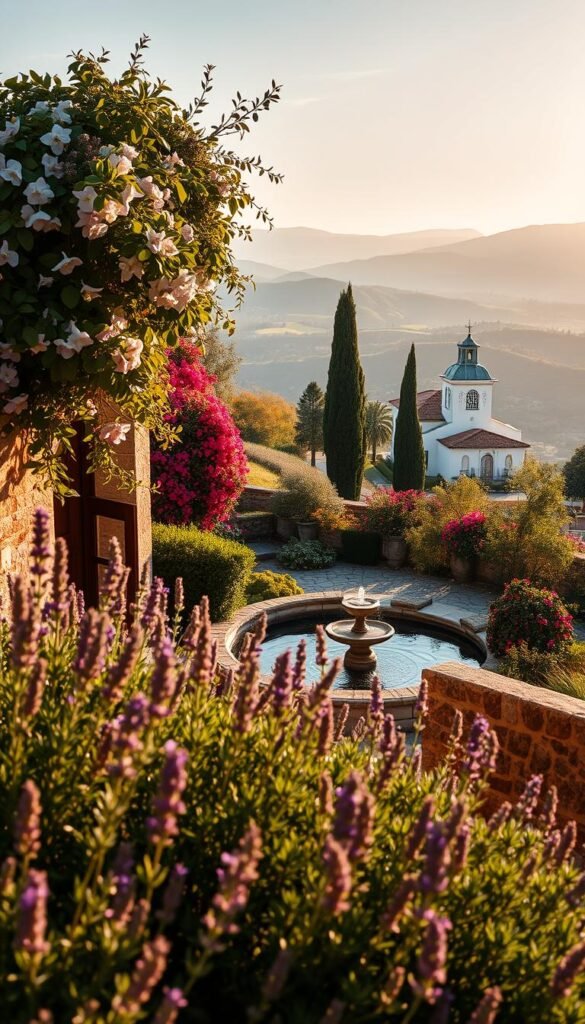Imagine stepping into an outdoor oasis where sun-baked terraces meet fragrant blooms and the gentle murmur of water features. This style celebrates drought-resistant landscapes that thrive in warm climates, blending practicality with relaxed elegance. Inspired by seaside regions from Southern Europe to North Africa, these spaces turn every backyard into a vacation-like escape.
What makes this approach unique? It’s built around sensory-rich experiences – think lavender-scented breezes, textured stone pathways, and vibrant ceramic accents. You’ll learn how to combine natural materials like weathered wood and terracotta with climate-smart plants that need minimal watering. Even small patios can become inviting sanctuaries through clever space planning.
Our guide shows how to balance beauty and function, whether you’re elevating your outdoor space or starting from scratch. Discover ways to incorporate water elements as focal points while choosing foliage that withstands dry spells. We’ll help you craft an environment perfect for alfresco meals or quiet moments of relaxation.
By embracing these principles, you’ll create more than just a yard – it becomes a personal haven that mirrors the carefree spirit of coastal living. Let’s explore how to blend timeless aesthetics with modern adaptability for lasting enjoyment.
Understanding the Mediterranean Garden Aesthetic
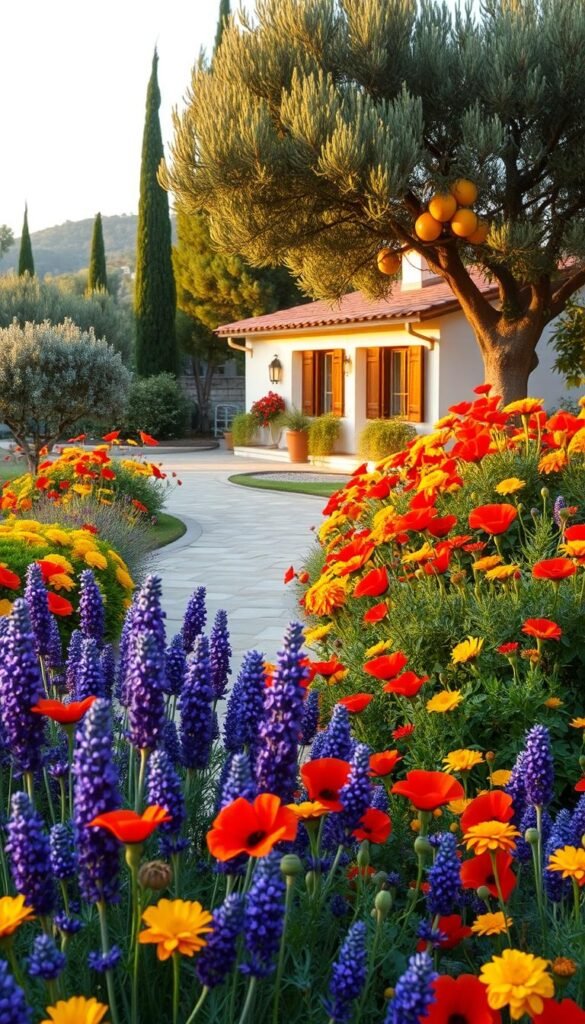
Picture a space where time slows down, and every detail whispers of sun-drenched coasts. This style isn’t about manicured perfection – it’s about crafting a sense of effortless harmony between nature and human touch. Think mottled clay pots softening under decades of sunlight, or gravel paths crunching softly underfoot.
Embracing the Warm, Relaxed Vibe
You’ll find warmth in every corner here. Walls wear faded blues like weathered fishing boats, while textiles echo the golden hour glow. Materials age gracefully, their cracks telling stories of seasons passed. “Beauty lies in the patina,” as local artisans often say.
| Color Inspiration | Natural Source | Design Application |
|---|---|---|
| Terracotta Orange | Clay-rich soil | Floor tiles, planters |
| Cobalt Blue | Deep sea waters | Mosaic accents, cushions |
| Mustard Yellow | Summer sunlight | Textiles, painted doors |
Recognizing Key Mediterranean Landscapes
Look for slopes dressed in silvery-green olive trees and herbs that release fragrance when brushed. Drystone walls frame views, while drought-smart shrubs thrive in rocky soil. These elements work together to create a backdrop that feels both wild and welcoming.
In coastal regions, you’ll spot succulents clinging to cliffs and bougainvillea cascading over pergolas. These features aren’t just pretty – they’re practical solutions for thriving in sunny, dry climates. Your outdoor area can mirror this balance with strategic plant choices and natural shading.
Planning Your Mediterranean Garden Layout
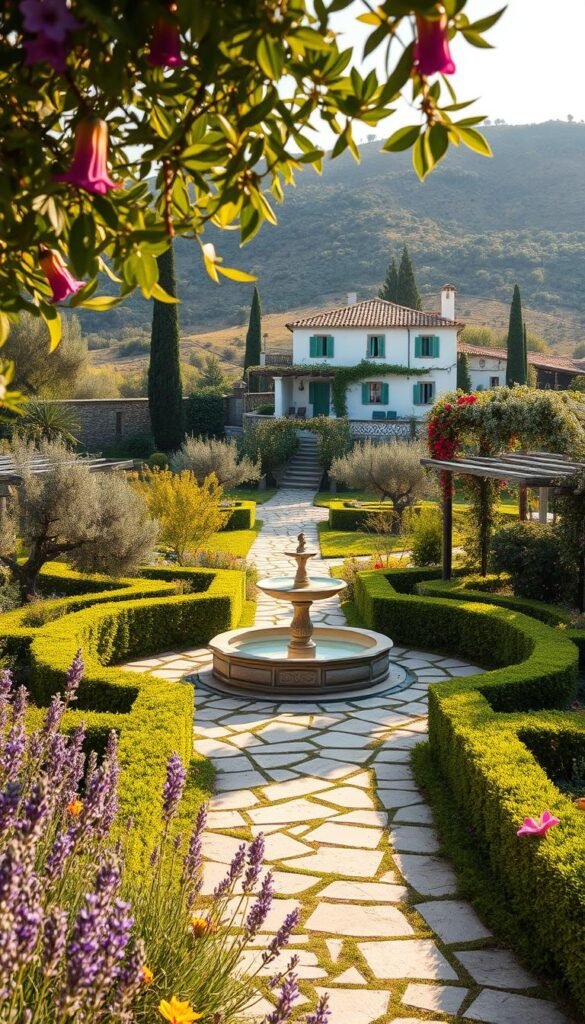
Every thriving space starts with a thoughtful blueprint tailored to its environment. Before choosing plants or decor, understanding your yard’s natural rhythm sets the stage for success. Let’s map out how sunlight, soil, and structure work together.
Assessing Sunlight, Soil, and Space
Start by tracking how light moves across your area. Most sun-loving varieties need 6+ hours of direct exposure. Use a simple sun calculator or observe shadows hourly. Poor drainage? Test soil texture:
- Sandy soil drains quickly but needs organic matter
- Clay holds moisture – mix in gravel or perlite
- Raised beds solve soggy ground issues
Create zones based on function: dining corners near your home, quiet nooks under trees. One landscape designer notes: “Sketching reveals hidden opportunities – like repurposing a sloped area into terraced planters.”
Sketching Your Vision for Outdoor Living
Grab graph paper or digital tools to visualize flow. Consider these elements:
- Pathways connecting key areas
- Focal points like water features
- Wind protection using walls or shrubs
Mark water sources and storage for easy irrigation. Balance open entertainment spaces with intimate seating tucked behind fragrant herbs. This planning phase turns challenges into charming features – rocky soil becomes a gravel garden, shady spots host climbing jasmine.
Essential Elements of Mediterranean Garden Design
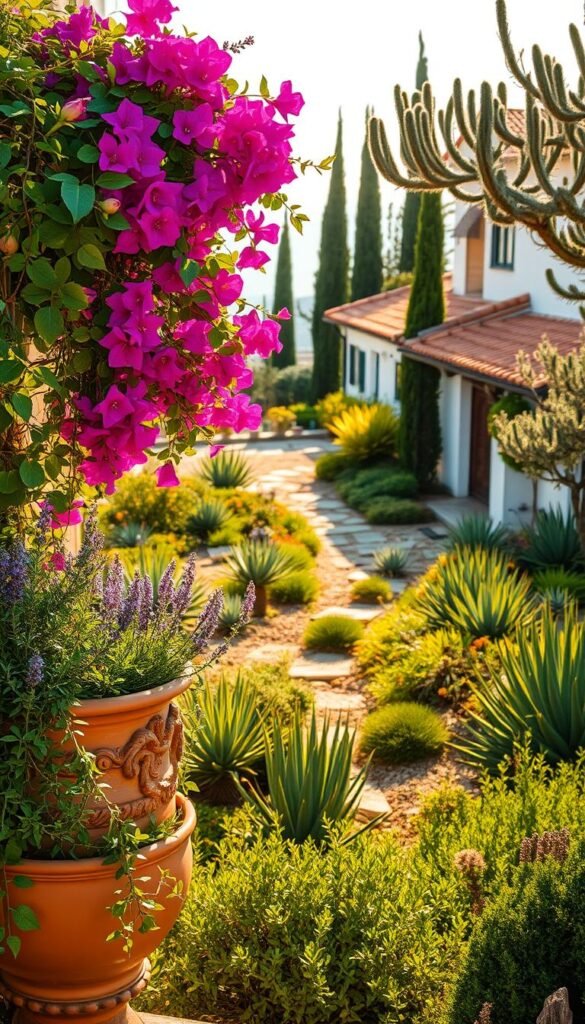
Transform your outdoor area by blending practical solutions with artistic touches. Three key components bring authentic character while handling hot, dry conditions gracefully. Let’s explore how these elements work together to create harmony.
Water Features for Cooling and Visual Appeal
A water feature acts like nature’s air conditioner. Wall fountains whisper softly in tight corners, while tiered designs make bold statements. Birdbaths attract pollinators, doubling as decorative art. “The sound of moving water instantly lowers stress levels,” notes landscape architect Clara Ruiz.
Use of Terracotta Pots, Tiles, and Gravel Paths
Sun-kissed terracotta pots add warmth to patios and pathways. Cluster varied sizes for dynamic displays, or use oversized urns as focal points. Pair them with gravel surfaces that mimic dry riverbeds – perfect for small patios needing drainage and texture.
Incorporating Stone, Pavers, and Outdoor Structures
Natural stone walls frame seating areas while retaining heat for evening warmth. Flagstone paths wind through aromatic herbs, their uneven edges enhancing rustic charm. Pergolas draped in vines create shaded retreats, proving structure can be both functional and beautiful.
Mediterranean Garden Design: Layout Inspiration and Plant Selections
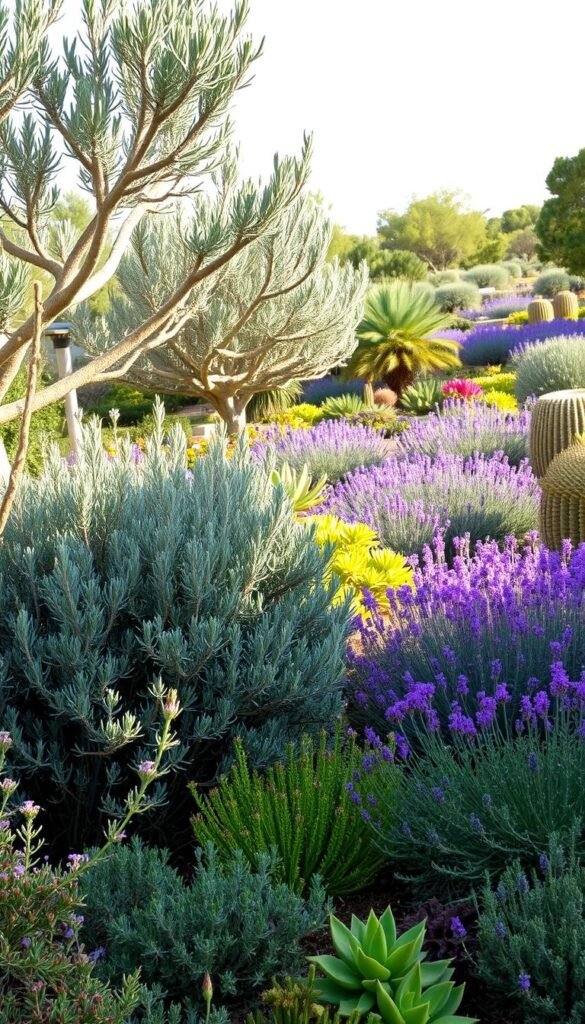
Building a resilient outdoor space starts with foliage that thrives in heat while delighting the senses. Focus on varieties that shrug off dry spells while offering visual drama and aromatic rewards. These selections bring coastal charm to any climate while cutting water use.
Choosing Drought-Tolerant and Fragrant Plants
Silver-leaved stars like lamb’s ear and artemisia reflect sunlight, keeping roots cool. Pair them with lavender spikes and rosemary bushes – their oils release summer scents when touched. For height, olive trees add structure, while trailing jasmine softens walls.
Consider these low-water favorites:
- Cotton lavender (Santolina) for geometric shapes
- Cardoon’s spiky silhouette as focal points
- Honeysuckle vines for evening fragrance
Creating Zones for Shade and Entertainment
Layer plants to craft microclimates. Citrus trees filter sunlight over seating nooks, while ornamental grasses rustle in breezes. Grapevines on pergolas create dappled shade – perfect for small patios needing vertical solutions.
Arrange seating areas near fragrant herbs where foot traffic releases their aroma. Leave open spaces for al fresco dining, edged with drought-smart flowers like salvia. This zoning approach balances sun exposure while creating inviting destinations.
Integrating Outdoor Living Spaces with Mediterranean Flair
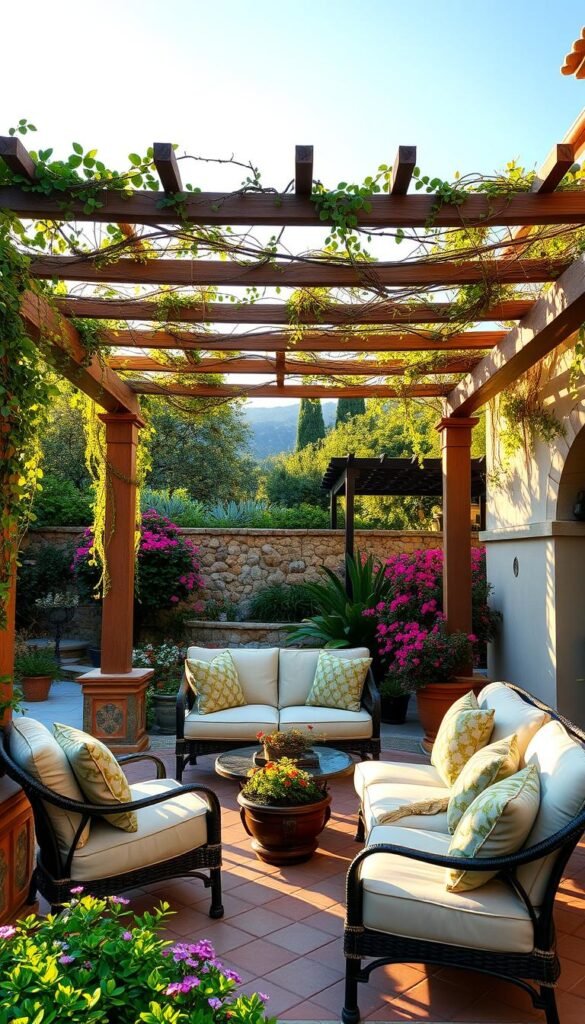
Crafting an outdoor retreat begins with understanding how shade and seating work together. These spaces become natural extensions of your home, blending comfort with nature’s rhythms. Picture dappled sunlight filtering through wooden beams while a breeze carries the scent of blooming herbs.
Designing Relaxing Courtyards and Seated Areas
Start by positioning seating under pergolas or mature trees. These structures provide shade while framing views of your surroundings. A simple iron bistro set works for morning coffee, while sectional sofas accommodate weekend gatherings. Landscape designer Marco Silva advises: “Let furniture materials echo nature – wrought iron mimics vine patterns, weathered wood complements stone walls.”
Consider these elements for versatile spaces:
- Portable containers with aromatic rosemary or citrus trees
- Weather-resistant cushions in sunset hues
- Overhead string lights for evening ambiance
Arrange seating to catch cooling breezes, keeping pathways clear to your home’s interior. For smaller areas, try patio container gardening to add greenery without crowding. Swap potted plants seasonally – bright geraniums in summer, evergreen shrubs in winter.
These zones thrive when they feel intentional yet effortless. Add mosaic side tables or hand-painted tiles as conversation starters. Your outdoor haven becomes a daily destination – for quiet reflection or lively meals under the stars.
Creating Textural Interest with Stones, Gravel, and Tiles
Textures tell stories underfoot and through every carefully placed element. Crunchy gravel pathways contrast with smooth stone patios, while vibrant tiles add bursts of color. These materials work together to build a landscape that feels both rugged and refined.
Arranging Paved Walkways and Mosaic Details
Start with gravel—it’s more than just ground cover. Fine crushed stone suits formal paths, while chunky river rocks create drainage-friendly borders. For patios, mix sizes to mimic natural riverbeds. Steel edging keeps edges crisp but lets plants spill over softly.
Mosaics bring artistry to functional spaces. Arrange stone pebbles into geometric patterns between pavers, or outline steps with cobblestones. Brightly glazed tiles shine on stair risers or tabletops, nodding to ancient craftsmanship. Mixing vintage and modern elements? Try terracotta pots with steel planters for balance.
Let materials age gracefully. Weathered terracotta pots develop character, while gravel paths shift underfoot like coastal trails. These touches transform your space into a tactile retreat that evolves with time.

